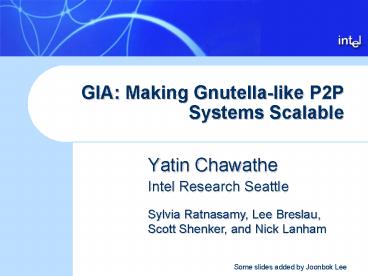GIA: Making Gnutellalike P2P Systems Scalable - PowerPoint PPT Presentation
1 / 17
Title:
GIA: Making Gnutellalike P2P Systems Scalable
Description:
Distributed file-sharing applications. E.g., Napster, Gnutella, KaZaA. File sharing is the dominant P2P app. Mass-market. Mostly music, some video, software ... – PowerPoint PPT presentation
Number of Views:223
Avg rating:3.0/5.0
Title: GIA: Making Gnutellalike P2P Systems Scalable
1
GIA Making Gnutella-like P2P Systems Scalable
- Yatin Chawathe
- Intel Research Seattle
Sylvia Ratnasamy, Lee Breslau, Scott Shenker,
and Nick Lanham
Some slides added by Joonbok Lee
2
The Peer-to-peer Phenomenon
- Internet-scale distributed system
- Distributed file-sharing applications
- E.g., Napster, Gnutella, KaZaA
- File sharing is the dominant P2P app
- Mass-market
- Mostly music, some video, software
3
The Problem
- Potentially millions of users
- Wide range of heterogeneity
- Large transient user population
- Existing search solutions cannot scale
- Flooding-based solutions limit capacity
- Distributed Hash Tables (DHTs) not necessarily
appropriate
4
Why Not DHTs
- Structured solution
- Given a filename, find its location
- Can DHTs do file sharing?
- Probably, but with lots of extra workCaching,
keyword searching - Do we need DHTs?
- Not necessarily Great at finding rare files, but
most queries are for popular files
5
Why Not DHTs
- Structured solution
- Given a filename, find its location
- Tightly controlled topology file placement
- Unsuitable for file-sharing
- Transient clients cause overhead
- Poorly suited for keyword searches
- Can find rare files, but that may not matter
6
Our Solution GIA
- Unstructured, but take node capacity into account
- High-capacity nodes have room for more queries
so, send most queries to them - Will work only if high-capacity nodes
- Have correspondingly more answers, and
- Are easily reachable from other nodes
7
GIA Design
- Make high-capacity nodes easily reachable
- Dynamic topology adaptation
- Make high-capacity nodes have more answers
- One-hop replication
- Search efficiently
- Biased random walks
- Prevent overloaded nodes
- Active flow control
- Make high-capacity nodes easily reachable
- Dynamic topology adaptation
- Make high-capacity nodes have more answers
- One-hop replication
- Search efficiently
- Biased random walks
- Prevent overloaded nodes
- Active flow control
Query
8
Dynamic Topology Adaptation
- Make high-capacity nodes have high degree (i.e.,
more neighbors) - Per-node level of satisfaction, S
- 0 ? no neighbors, 1 ? enough neighbors
- Function of
- Nodes capacity ? Neighbors capacities
- Neighbors degrees ? Their age
- When S ltlt 1, look for neighbors aggressively
9
Dynamic Topology Adaptation
10
Flow Control
- RWRT Problem
- Random work bias to high degree nodes.
- But high degree node does not mean high capacity
nodes. ? Overloaded high degree nodes. - Active Flow control using token
- Send query to a neighbor only if that neighbor is
willing to accept query from the sender. - Token means I am willing to accept your query.
- Assign tokens to its neighbor in proportion to
neighbors capacities.
11
Simulation Results
- Compare four systems
- FLOOD TTL-scoped, random topologies
- RWRT Random walks, random topologies
- SUPER Supernode-based search
- GIA search using GIA protocol suite
- Metric
- Collapse point aggregate throughput that the
system can sustain
12
Questions
- What is the relative performance of the four
algorithms? - Which of the GIA components matters the most?
- How does the system behave in the face of
transient nodes?
13
Collapse Point (CP)
14
System Performance
15
Factor Analysis
16
Transient Behavior
Static SUPER
Static RWRT (1 repl)
17
Summary
- GIA scalable Gnutella
- 35 orders of magnitude improvement in system
capacity - Unstructured approach is good enough!
- DHTs may be overkill
- Incremental changes to deployed systems
- Status Prototype implementation deployed on
PlanetLab
18
Remarks
- Malicious Nodes
- Other Considerations
- Physical Topology
- Contents
19
GIA Design
- Make high-capacity nodes easily reachable
- Dynamic topology adaptation
- Make high-capacity nodes have more answers
- One-hop replication
- Search efficiently
- Biased random walks instead of flooding
- Prevent nodes from getting overloaded
- Active flow control
- Make high-capacity nodes easily reachable
- Dynamic topology adaptation
- Make high-capacity nodes have more answers
- One-hop replication
- Search efficiently
- Biased random walks instead of flooding
- Prevent nodes from getting overloaded
- Active flow control
20
GIA Design
- Make high-capacity nodes easily reachable
- Dynamic topology adaptation
- Make high-capacity nodes have more answers
- One-hop replication
- Search efficiently
- Biased random walks
- Prevent overloaded nodes
- Active flow control
- Make high-capacity nodes easily reachable
- Dynamic topology adaptation
- Make high-capacity nodes have more answers
- One-hop replication
- Search efficiently
- Biased random walks
- Prevent overloaded nodes
- Active flow control
21
Factor Analysis
TADAPT 0.001
TADAPT 0.2
RWRT 0.0005
OHR 0.005
BIAS 0.0015
GIA 7
OHR 0.004
BIAS 6
FLOWCTL 0.0006
FLOWCTL 2































